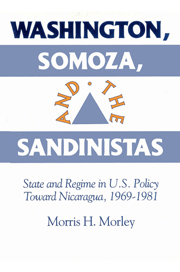Book contents
- Frontmatter
- Contents
- Acknowledgments
- 1 Introduction: Permanent and transitory interests in U.S. foreign policy
- 2 Washington and the Somoza dynasty: From consolidation to crisis of a client dictatorship
- 3 Supporting Somoza: Substance and symbol in American policy during the Nixon-Ford era
- 4 The Carter administration and Nicaragua: Human rights and the politics of accommodation
- 5 The Carter administration and Nicaragua: Mediation and the politics of frustration
- 6 Washington ruptures a historic relationship: Dumping the dictator to save the state
- 7 The Carter administration and revolutionary Nicaragua: Containing Sandinista power
- 8 Conclusion
- Bibliography
- Index
1 - Introduction: Permanent and transitory interests in U.S. foreign policy
Published online by Cambridge University Press: 31 March 2010
- Frontmatter
- Contents
- Acknowledgments
- 1 Introduction: Permanent and transitory interests in U.S. foreign policy
- 2 Washington and the Somoza dynasty: From consolidation to crisis of a client dictatorship
- 3 Supporting Somoza: Substance and symbol in American policy during the Nixon-Ford era
- 4 The Carter administration and Nicaragua: Human rights and the politics of accommodation
- 5 The Carter administration and Nicaragua: Mediation and the politics of frustration
- 6 Washington ruptures a historic relationship: Dumping the dictator to save the state
- 7 The Carter administration and revolutionary Nicaragua: Containing Sandinista power
- 8 Conclusion
- Bibliography
- Index
Summary
Interpreting U.S. foreign policy toward the Third World: State versus regime
The practice of contemporary U.S. policy toward Latin America is shaped by three broad-based concerns: support for open economies and development strategies that accord private foreign banking and investment capital a key role; support for regimes prepared to align themselves with efforts to contain, and even roll back, the forces of national and social revolution; and a determination to safeguard America's strategic and “national security” interests in conformity with regional and global goals. Throughout the 1950s, 1960s, and 1970s, Washington policymakers pursued these interrelated political, economic, and strategic objectives in association with, or through, an assortment of military or military-controlled governments that dominated the political landscape of the region.
Toward the end of the 1970s, however, the United States was forced to come to terms with an emerging new reality: dictatorships that had lost their capacity to enforce controls over their populations – that is, had experienced a widespread erosion of political legitimacy; the collapse of the dominant economic model as it became increasingly incapable of responding to minimal class-based socioeconomic demands; and the appearance of massbased, polyclass movements demanding a return to civilian rule. These developments forced the Carter, and subsequently Reagan, administrations to rethink the relationship between current strategies and broader policy objectives in the hemisphere. The principal dilemma confronting the White House was whether, and in what circumstances, it should withdraw support from disintegrating allies and throw its influence behind the forces pushing for a return to electoral politics.
- Type
- Chapter
- Information
- Washington, Somoza and the SandinistasStage and Regime in US Policy toward Nicaragua 1969–1981, pp. 1 - 32Publisher: Cambridge University PressPrint publication year: 1994



